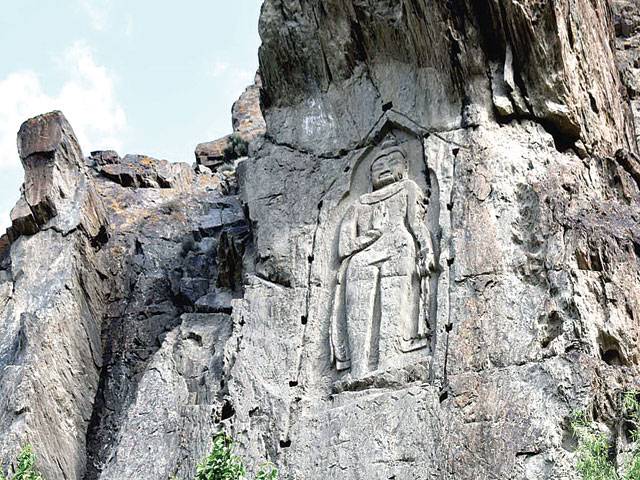GILGIT BALTISTAN - Gilgit-Baltistan has been at the crossroads of cultures, religions and civilisations for centuries.
Before introduction of Islam in the region, the people used to practice Buddhism or multiple forms of local pagan religions.
The introduction of a rich cultural heritage and spread of Buddhism in Gilgit and surrounding regions is deeply linked to the movement along the Silk Route. Historical facts reveal that religious Buddhist caravans used to stay in a monastery here while passing through Gilgit.
Kargah Buddha which is called Yashani in local language, a unique archaeological site a 7th century Buddha figure carved deep into the solid rock located outside of main Gilgit city about 9 km.
Large standing Buddha with carved image in the cliff-face in Karghah Nala. Nearby towns are Barmas, Khur and Napura Baseen are adjoining towns.
Since the 3rd century to the 11th century, Gilgit was a Buddhist center, a Buddhist monastery and three stupas containing Sanskrit manuscripts were excavated in 1931. According to an estimate the carving was completed in the 7th century. The Buddha was discovered alongwith ruins of a Buddhist monastery and three stupas about 400 meters upriver from the Buddha itself in 1938-39 following the discovery of so-called Gilgit manuscripts in 1931.
Every year thousands of Buddhists from Japan, Korea and other parts of the world come to Gilgit city to see the Statue of Kargha Buddha. According to Tourism Department GB in the year of 2018-19 more than half million tourists visited Gilgit to see the Buddha.
Senior journalist Abdul Rehman Bukhari while talking to APP said, “The Kargah Buddha needs attention of the archaeological department of Gilgit Baltistan for preservation and safeguarding.
“The statue has remained intact so far, and should continue to remain for the future generations” he added.
Rehman further added that the road to Buddha from Gilgit city is in very poor condition and needed repair so that it can be accessible for tourists easily”.
Local residents have an interesting myth about Kargah Buddha; Arshad Wali a resident of Baseen nearby town of Kargha Budha while talking to APP said, “once upon a time there lived an ogress called Yakhshini whom local people wanted to get rid of as it used to eat human flesh, The villagers asked a passing saint for help and the saint was said to have succeeded in pinning her to the rock.”
Raqeeb a local resident of Baseen said, “The series of wholes making the boundary around the Buddha are actually believed pinhole holding ogress tight”.
Later the saint declared that she would not bother them as long as the saint was alive. And if they buried the saint at the foothills of the rock, she would never be freed.” The saint was said to have buried right below the Buddha statue. Arif Hussain Director Gilgit Development Authority (GDA) while talking to APP said that for the preservation and protection of Kargah Budha GDA was constructing traditional boundary wall, stream, grinder machine (pun chakhi in Urdu or Yoor in local language), huts and stand to view the Buddha statue easily with close eyes.
For these constructions more than Rs 10 million were being spent, he added.






